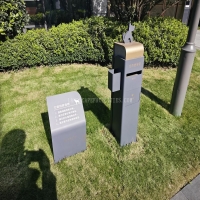Welcome to the website for landscape facilities products and knowledge.
How does the table’s design facilitate easy integration with outdoor navigation or wayfinding systems?
Modern outdoor tables are no longer just static furniture pieces; they have evolved into sophisticated integration points for navigation and wayfinding systems. The key to this seamless integration lies in several deliberate design elements that prioritize both functionality and durability.
First, the material selection plays a crucial role. Tables designed for integration typically use non-interference materials like powder-coated steel, concrete, or specific polymers that don't block wireless signals. This ensures that Bluetooth beacons, RFID tags, or Wi-Fi modules embedded within or mounted on the table can communicate effectively with users' devices and central navigation systems without signal degradation.
The physical architecture incorporates standardized mounting interfaces. Many tables feature universal mounting plates, concealed conduits, and waterproof compartments that allow cities and venues to install wayfinding technology quickly and securely. These interfaces accommodate everything from simple QR code holders to sophisticated digital displays and interactive kiosks, making the tables future-proof as technology evolves.
Strategic component placement is another critical factor. Designers position technological elements at optimal heights for user interaction while protecting them from environmental damage and vandalism. Important components are often placed under protective ledges or within recessed areas that shield them from direct rain, sunlight, and physical impact while remaining accessible to users.
Many modern tables also incorporate power management systems. Some feature integrated solar panels that can power LED indicators, small displays, or charging stations, while others include connections for hardwired power sources. This eliminates the need for separate power infrastructure specifically for the navigation components, simplifying installation and maintenance.
The table surfaces themselves often serve dual purposes. Beyond their primary function, they may include engraved maps, directional indicators, or standardized symbol placements that work in harmony with digital wayfinding systems. This creates a multi-layered navigation experience where physical and digital elements reinforce each other, making the system more resilient and accessible to diverse users.
Furthermore, the aesthetic integration ensures these tables blend seamlessly into their environments while remaining identifiable as navigation points. Designers use color coding, subtle lighting, and consistent branding elements that help users quickly recognize them as wayfinding resources without compromising the outdoor aesthetic.
Through these thoughtful design considerations, outdoor tables transform from simple street furniture into intelligent nodes within broader navigation ecosystems, providing consistent orientation points that help people move through complex outdoor spaces with confidence and ease.
Related search:

Recommendation
Outdoor cat and dog feces trash can; Community pet trash can; Metal multi-color design